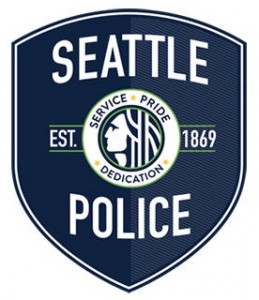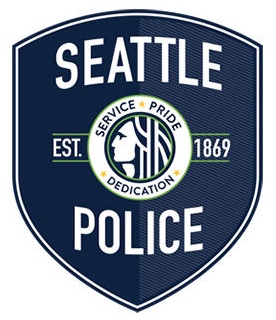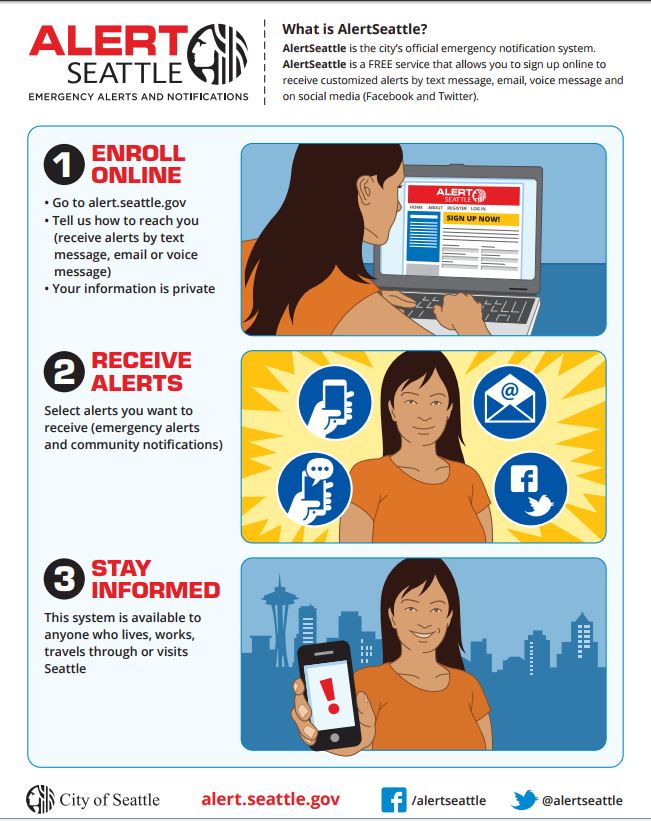|
|
 This month’s guest speaker was SPD Chief Carmen Best, who’s interim chief until a new one is hired. She’s been with the force for 26 years. She laid out her priorities: This month’s guest speaker was SPD Chief Carmen Best, who’s interim chief until a new one is hired. She’s been with the force for 26 years. She laid out her priorities:
– Reduce crime and disorder
– Excellent service, doing work the community expects and wants
– Work with honor and professionalism, and to feel proud of working for SPD
– Business efficiency. Budget is $352 million; be thoughtful about spending
it wisely
– Data-driven policies and practices – use technology to do a better job
getting information to officers and the community; deploying resources;
solving crimes
For the North Precinct Captain’s report, he said that person crimes are up 14% year to date compared to last year’s YTD, and property crimes are down 8%. He noted that Lake City and around Northgate Mall (I-5 to Roosevelt Way NE between NE 92nd St & NE 115th St) have seen an uptick in crime so those areas have been receiving more SPD attention, as well as a few other areas in the north end.
For more comments and questions answered by Chief Best and more precinct news and crime statistics, read the minutes. The minutes are here.
 How do you turn right across a bike lane? In Washington you’ll want to check for and yield to bicyclists, then merge INTO the bike lane so you’re making your right turn from the curb. How do you turn right across a bike lane? In Washington you’ll want to check for and yield to bicyclists, then merge INTO the bike lane so you’re making your right turn from the curb.
Washington’s law on right turns directs the driver to make the turn from “as close as practicable to the right-hand curb or edge of the roadway.” That brings up a question – on a road with a bike lane, is the edge of the roadway the line that separates the car lane from the bike lane, or is it the curb? According to the Revised Code of Washington, the roadway is the portion of the highway “ordinarily used for vehicular travel.” Since a bicycle is considered a vehicle in the law, a bike lane is used for vehicular travel. That would imply that drivers should merge into the bike lane to make a right turn. However, many drivers understand a solid line in the roadway to mean “do not cross,” which confuses the situation. Many states have clear statutes regarding right turns and bike lanes; Washington doesn’t.
On a national level, the Manual on Uniform Traffic Control Devices encourages road designers to use dotted lines on bike lanes as they near intersections so drivers know they can move into the bike lane prior to the intersection. Here’s how it works: The driver signals a right turn, checks the bike lane for cyclists and, if clear, moves right. If a bike rider is in the lane, the car yields to the bike and then moves into the lane. A cyclist in the bike lane intending to turn right would stop behind the car instead of pulling up next to it on the right. A cyclist intending to go straight would go around the LEFT side of the car.
Locally, traffic engineers are designing new bike lanes to include dotted lines at intersections, but we still have plenty of lanes with solid lines. So what do you do if you’re intending to turn right and there’s a solid white stripe for the bike lane? The law supports merging into the bike lane, but some motorists and cyclists may not expect it. Use caution and give each other a bit of grace; drivers and riders are still learning to coexist on the roads.
Note that a car is not allowed to drive in a bike lane except when making a right turn. You may not drive in a bike lane to pass on the right to get around a car turning left.
This is from an article in the Bellingham Herald.
SDOT is hosting three informal drop-in sessions for the Northgate Ped/Bike Bridge project later this month. SDOT recently updated the west approach to the bridge, in response to concerns raised by North Seattle College. At these drop-in sessions, SDOT will share the latest design, provide updates on public art, talk about the 1st Ave NE protected bike lane, and give information on SEPA environmental review.
Here are the details:
Monday, March 19: 12 – 1:30 PM
North Seattle College, The Grove, 9600 College Way N
Tuesday, March 20: 8 – 9:30 AM
Aljoya Thornton Place, 450 NE 100th St
Wednesday, March 21: 5 – 6:30 PM
Neighborcare Health at Meridian, Room 110, 10521 Meridian Ave N
Drop-in sessions are opportunities for you to speak with project staff in an informal setting when it’s convenient for you. If you can’t make one of these events, SDOT will also post the same information on its project webpage as soon as March 12.
SDOT will soon complete SEPA environmental review and will issue a Mitigated Determination of Non-Significance (MDNS) and SEPA checklist in March. There will be a 14-day public comment period followed by a 7-day appeal period on the MDNS and SEPA checklist. SDOT will notify the community when the SEPA documents are issued, where to find them, what the comment period dates are, and how to comment on its website and through its project email listserv.
This month’s art in Pinehurst Pocket Park is a lovely moose, drawn by five year old Greta. It least she was five two Pinehurstfests ago when she drew it! You can see this in the kiosk at NE 117th St & 19th Ave NE. Thanks, Greta! P.S. want to make another picture for the park now that you’re older? We’d love it!
If you would like to submit your child’s artwork (or yours!) for the Pocket Park, please email nancy@pinehurstseattle.org.

Seattle Department of Neighborhoods announces the Community Resource Hub (http://www.seattle.gov/resourcehub) – an online portal of City resources, information, and tools to help community members connect and engage with city government and with each other. The site features “how-to” documents, videos, websites, tip sheets, links to discounted City resources, and more.
“To create opportunities and broaden accessibility, we are constantly striving to make improvements,” said Kathy Nyland, director of Seattle Department of Neighborhoods. “The city has so many valuable resources available that we wanted to create a “one-stop shop” to make it easier for community members. Their requests are what inspired the Community Resource Hub.”
The portal is divided into three sections:
GET INFORMED provides the basics of government, along with information on City resources and opportunities.
GET ENGAGED shares useful web tools to help people connect and engage with government and with each other.
GET ORGANIZED provides City resources for those ready to organize their neighborhood or community.
Here are a few highlights of the new Community Resource Hub:
- The Community Connector website is a crowd-sourced list of community and not-for-profit organizations to help Seattleites connect with organizations that share their interests.
- Our Accessing Government video series shares information on how government works, how to access it, how to connect with it, and how to use your voice within it.
- The Add Your Voice webpage is where you can find opportunities to give your input and feedback on a variety of City plans and projects.
- Get Informed Toolbox provides links to information, workshops, and resources that are free or discounted.
- Get Organized Toolbox has tip sheets and templates for organizing a neighborhood/community group, such as successful meeting tips, recruitment ideas, and publicity tools.
New tools and resources will be coming online throughout the year, so visit the site often to Get Involved, Get Engaged, and Get Organized.
 Seattle Police Department has some charts and graphs about crime on its crime dashboard. You may be interested in browsing the data. The top page is here: https://www.seattle.gov/police/information-and-data/crime-dashboard. You can choose the year, precinct, neighborhood, crime, etc. Seattle Police Department has some charts and graphs about crime on its crime dashboard. You may be interested in browsing the data. The top page is here: https://www.seattle.gov/police/information-and-data/crime-dashboard. You can choose the year, precinct, neighborhood, crime, etc.
On the left side of that page are links to several specific sets of data, such as use-of-force, officer involved shootings, bias crimes, crisis contacts.
Also on the left is a link to SeaStat, slides from weekly review meetings with the police captains and chief. The sample graphs below are from the January 17, 2018 SeaStat meeting slides.
 
 This month’s guest speaker was our North Precinct Crime Prevention Coordinator, Mary Amberg. She’s the go-to person to help you set up a block watch, to do a security assessment of your residence, to talk to if you are unhappy with the way your 911 call went, etc. She gave many good tips for helping to prevent property crimes at your residence. To see them, and other news including year-to-date crime statistics for the north precinct, read the meeting minutes here. This month’s guest speaker was our North Precinct Crime Prevention Coordinator, Mary Amberg. She’s the go-to person to help you set up a block watch, to do a security assessment of your residence, to talk to if you are unhappy with the way your 911 call went, etc. She gave many good tips for helping to prevent property crimes at your residence. To see them, and other news including year-to-date crime statistics for the north precinct, read the meeting minutes here.
Contact Mary at Mary.Amberg@seattle.gov or 206-684-7711.
Something to think about subscribing to:

 Our February 2018 meeting featured SPD Community Police Team Officer Bryan Kennedy speaking about crime trends and how SPD handles property crimes once they’ve been reported. Our February 2018 meeting featured SPD Community Police Team Officer Bryan Kennedy speaking about crime trends and how SPD handles property crimes once they’ve been reported.
We also invited a speaker from Seattle Neighborhood Group who gave a presentation on suspicious behavior. The meeting notes are here.
This month’s drawing in the pocket park is by four year old Junie. She made it at a prior Pinehurstfest. Thanks Junie, looks great! The park is at NE 117th St & 19th Ave NE.

If you would like to submit your child’s artwork (or yours!) for the Pocket Park, please email nancy@pinehurstseattle.org.
|
Join us on Facebook or Google+
|
 This month’s guest speaker was SPD Chief Carmen Best, who’s interim chief until a new one is hired. She’s been with the force for 26 years. She laid out her priorities:
This month’s guest speaker was SPD Chief Carmen Best, who’s interim chief until a new one is hired. She’s been with the force for 26 years. She laid out her priorities:








